COFFEE MATHING MADE EASY
IT IS A RECIPE AFTER ALL
I’m often asked, “How many scoops does it take to make great coffee?” When I say I don’t use scoops at all, there is usually a look of confusion on the asker's face. When I mention that I weigh the beans and water to ensure the proper ratio, those confused looks turn to blank stares. I’ve seen donuts with less glaze.
I believe “two scoops per 8oz cup” is a conspiracy designed by bulk coffee companies to get you to use (and, therefore, buy) more coffee, but that’s just me.
To turn great quality beans and excellent water into the perfect cup of deliciousness, there is no way around it; you’ve got to know exactly how much of each to use. Imagine making a cake and guessing how much flour or milk you’ll use. There is no reasonable expectation that it will turn out well, let alone perfectly. And if it does, how will you duplicate it next time if you don’t know how much of each ingredient you used this time?
It’s the same for coffee. How much water? How much coffee? How can I do math without caffeine? Cake? Did someone mention cake?
RELAX. IT’S A SIMPLE 2-STEP PROCESS.
Fret not, friend. It’s easy peasy, and I’m not even close to being a mathlete. To find your perfect cup, all you need, beyond quality ingredients and a brewer, is a kitchen scale, a calculator, and a starting point.
That starting point is called “the ratio.” For this discussion, we will use one unit of coffee to twenty units of water, a 1:20 ratio. Most coffee recipes you’ll see are expressed in that format- 1:18 = one part coffee, 18 parts water, and so on.
Use grams, ounces, or milliliters. It doesn’t really matter as long as you use that same unit of measurement for both the beans and the water. I prefer grams. I’ll tell you exactly why I avoid using scoops and tablespoons in a moment.
First, I use this simple two-step method in my SimplyGoodCoffee brewing machine at Ole Dog’s. (Shameless plug: It’s an electric pour-over machine, and you can click here to check it out online or come into the store for a demo. Right now, there is a $25 discount and free same-day shipping.)
STEP 1 - Fill your water carafe with as much water as you want to use. In this example, I weigh out 600 grams of water. (Don’t trust the lines on your coffee carafe. Use the kitchen scale.)
STEP 2 - Use your calculator and divide 600 by 20. The answer is 30, and that’s how many grams of coffee beans I will use.
That’s all there is to it! I will pour 600 grams of water into the brewer and 30 grams of coffee into the filter and push the start button. I know how it will turn out because I do it that way every single time.
If you try that and discover the coffee is too weak or strong for you, simply adjust the ratio up or down. The cool thing about zeroing in on your ratio is that once you have it, you can make as much or as little as you want, and it will taste the same every time.
DON’T SCOOP & GUESS
You can’t get precise if you measure by “scoops.” One scoop might have 8 grams of coffee, the next one 7, and another 9. That doesn’t seem like much, but adding four scoops to the filter basket could range from 28 to 36 grams of coffee, which is more than 20% variance. The same goes for water; you could be off by 10-20% (or more) in either direction if you don’t weigh it out.
If your water is off by 10-20% and your coffee beans are off by 10-20%, I’m not a math whiz with a pocket protector, but the coffee flavor/intensity could be off by as much as 40% from one pot to the next. This makes finding and duplicating your perfect cup virtually impossible.
PEN AND PAPER ARE YOUR FRIENDS
On your quest for the perfect cup, the journey is all about controlling the variables. In future posts, we’ll discuss things like grind sizes, brewing methods, specific coffee recipes, and more. Variables are those things that can change. To know HOW to change them, you’ve gotta know where to begin.
ACTION STEP: For now, brew your coffee like you normally do, but experiment with the ratios. Weigh it out every time. WRITE DOWN YOUR MEASUREMENTS AND RESULTS so you can know which way to go next time as you dial in your preferences. If you did a 1:20 ratio and it was too weak for you, write down “1:20, too weak,” and next time you’ll know you didn’t like that and you’ll try a 1:19 ratio. And you’ll do that until you get the best possible cup you can without adjusting your grind settings and brew methods.
Lastly, you’ll find that different coffees are better with different ratios. You may discover that a dark roast is better when it’s more diluted, and a light roast is better when there is more coffee and less water.
Writing things down will prove helpful on your journey. (We even have coffee-tasting journals at Ole Dog’s to help you with this.)
That’s it for now. Thanks for reading. Keep me posted on your quest, and stay tuned for info about fun and helpful events like our home coffee-making classes. Our next one is THIS SATURDAY. YOU CAN CLICK HERE FOR DETAILS. In the meantime, be well, do good, and brew on!
